Ten Ways to be More Resourceful in the Kitchen
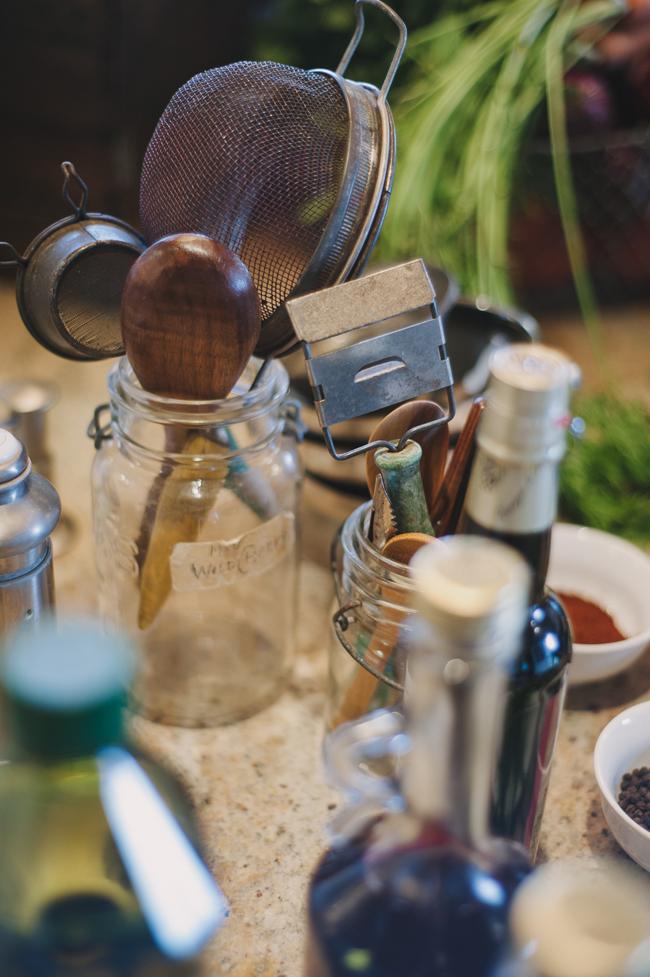
I’ve been incredibly inspired by the ALL resourcefulness I’ve seen over the past month from friends all around the world. As we’ve been limiting our trips unless deemed necessary, you are re-using, recycling, simplifying, and saving. You are more conscious about your purchasing. More intentional with your consumption. More creative in your cooking and more considered with your time spent at home. I polled my Instagram and asked in what ways you were personally being more resourceful and received some incredible answers. I’ve compiled some of my favorites, and today I’m sharing Ten Ways to be More Resourceful in the Kitchen.
What I love most about this list is that nothing is unrealistic or very difficult. Included below are ten simple, gentle shifts towards living slowly and with more intention and resourcefulness. These are actions we should all probably try to incorporate in our kitchens, all the time. These are tangible examples of how, when forced out of our comfort or convenience, we can open up an entirely new part of our creativity and ingenuity, perhaps one that we haven’t seen before.
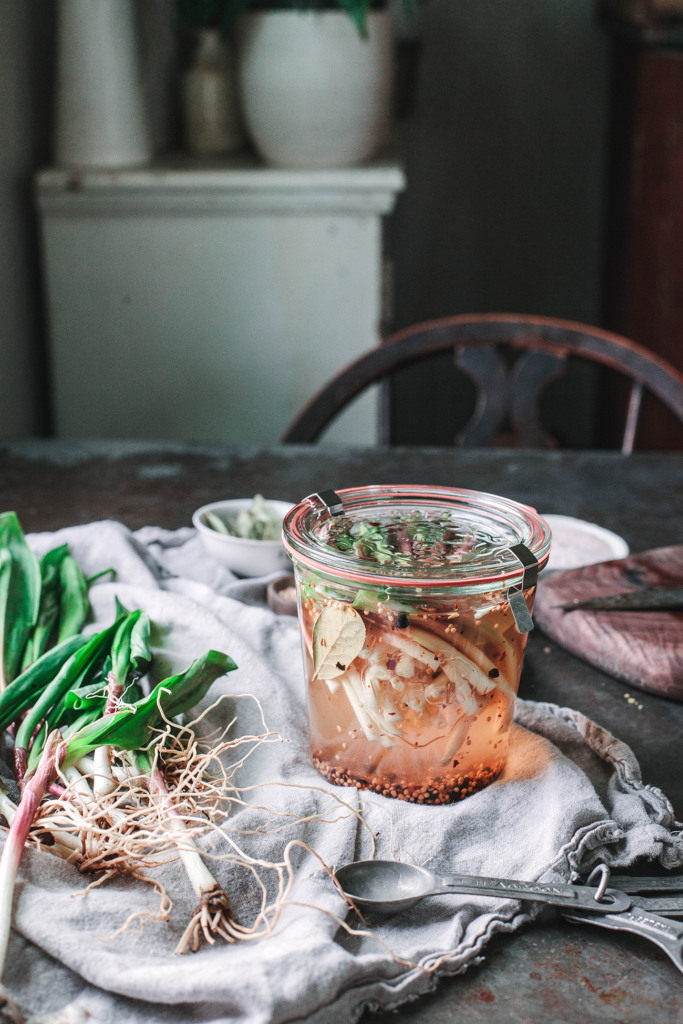
TEN WAYS TO BE MORE RESOURCEFUL IN THE KITCHEN
1. Plan modest meals and make the protein go further.
Plan modest meals. Soups and stews. Meals that go a long way, meals that give you the most bang for your buck. If you smartly plan these types of meals, you can get 2 or 3 dinners from one dish, which will be more budget-friendly and can result in less waste (and bonus: fewer trips to the grocery store). And, if you’re able, stretch the protein. Recipe calls for 1 pound of ground beef? Use 1/2 pound instead, throw in some extra beans or potatoes or veggies, and get two meals from the 1 pound package.
2. Use every last scrap of fresh food and leftovers before they go bad.
This one is huge! Do leftovers and vegetable bits get lost in your fridge? I’m the worst at this, but have personally been trying to be better about scouring the refrigerator every single day, making sure nothing’s going bad, that everything’s being eaten. Leftover sausage and leftover rice can be combined with leftover (or fresh or frozen) veggies to make the tastiest stir fry. Random bits of veggies can be tossed into soup for dinner (or freeze them use them for vegetable stock). Don’t let food go bad before you can get to it. If it does, you’re buying too much at once; sure, you want to have a well-stocked refrigerator, but you need to be realistic about your consumption.
3. Reuse things you might ordinarily throw out, like foil and ziploc bags.
It’s crazy how fast a box of ziploc bags can be consumed. And where are they going? Into the trash can, bye bye. If you must still use ziploc bags, reuse them! Wash them between uses, and hang them to dry over utensils in your dish rack. Same with the foil; unless it’s covered in something messy, reuse it! My grandmother always reused everything, and I thought it was kind-of silly as a younger person, but now I see the wisdom in her thrifty and resourceful behavior. You save money, and it’s better for the environment!
4. Keep the pantry organized; know what’s inside.
If your pantry is orderly, you will be able to see what’s in there and you will know what you have. This seems common sense, but like other areas in our life, the pantry can easily become a disorganized monster. A few years ago I developed A Capsule Kitchen Checklist, which outlines the essentials for the well-stocked minimalist kitchen. Then, I launched A Capsule Kitchen Challenge, which is a 7-day challenge designed to help you apply the checklist to your kitchen. It’s a great starting point for stocking and helping to keep the pantry organized so you can know just what’s inside its doors, at all times.
5. Make meals with what’s in the pantry and adapt recipes to use what’s on hand.
Being able to look at your pantry and refrigerator – whether bare or fully stocked – and put together a creative meal is an incredible skill to have. Sometimes it takes a little googling: “what can I make with quinoa, sweet potatoes, and black beans?” Sometimes it takes a little experimentation or desperation; I love making “fridge clean out” soup by throwing any and all veggie scraps/onions/etc into a pot, adding some seasoning and broth, maybe some rice or pasta, and calling it a day. It’s always delicious and the kids ask for seconds and thirds.
Knowing how to adapt recipes to use what’s on hand – instead of running to the store for 1 or 2 ingredients – is also a great skill. No butter? No eggs? No sugar? No yeast? Your best friend in these scenarios is google. There are countless articles outlining acceptable substitutions for almost any ingredient you can imagine. You will quickly learn common substitutions and be increasingly more confident experimenting and adapting in the kitchen.
6. Learn how to can/preserve/ferment.
Canning, preserving, and fermenting, especially from your own garden abundance, is one of the most rewarding kitchen tasks. You will reap from the work months, maybe even years, after the fact. Even if you don’t have a garden, you can learn and use this skill after shopping at the farmers’ market or local farms/orchards/etc. Canning and preserving is relatively simple and is a wonderful way to preserve the season and ensure you have fruits and vegetables stowed away for the winter months.
However, canning and preserving does take time, and you do want to educate yourself on the basics and ensure you are doing it safely to avoid botulism. This article outlines safe canning methods and they “why.” This book is a favorite and I reference it frequently; it discusses safe canning methods (without overwhelming or boring), has beautiful photography, and provides excellent recipes.
Fermenting is also a simple at-home way of preserving food. Kefir, kombuha, kimchi, sauerkraut, yogurt, and sourdough bread are all examples of relatively common fermented foods. To ferment vegetables, all you really need is salt and water, whatever you’re fermenting, and a glass jar with a lid. It’s a great way to not only extend the life of food, but fermentation has incredible health benefits, like making the food easier to digest and helping to restore the presence of friendly bacteria in your gut. Lots of great reasons to ferment your food (and it’s DELICIOUS, too)!
7. Use the food you have more creatively.
This goes hand-in-hand with #s 4 and 5 above. If you know what you have, use what’s on hand, and learn how to adapt recipes, you will likely start to cook more creatively. Rather than getting stuck in a rut and making the same meals over and over again, making something new and exciting. Commit to trying one new recipe every week. This cookbook (by my friends at Huckle & Goose) is a FAVORITE for simple, hearty, practical recipes that are full of flavor (and the writing is great, too). There’s always an unusual twist or something to make each recipe a little more fun and creative; I highly recommend checking out the cookbook. Use vegetables in a way you’ve never used them before. Try fermenting some veggies from the Farmers’ Market (all you really need is sea salt, veggies, and some filtered water). Combine spices for creative and new – to you – flavors. Stuck making the same old salad? Make some new dressings!
8. Keep kitchen scraps for soup, the garden, chickens, etc.
Keep scraps! There are a few options here. First, you can freeze all your vegetable scraps and use them to make veggie stock when you’ve compiled enough. If you produce way more kitchen waste than your freezer space permits, feed your chickens; they’ll eat almost any kitchen scraps you have.
If you don’t have chickens, you can also compost. Composting is simple and free, and an excellent way to minimize your trash. If you have a garden, it’s a great way to help your plants grow by providing necessary nutrients. It’s super easy to compost: just keep scraps on the kitchen counter in a bowl (you’ll want to dump outside daily) or in a bucket like this one. If you want to have your own compost pile, you can find great instructions here. If you don’t have space to compost in your own yard, do some research to see if you have any local compost pick up services. Here in Loudoun County, Virginia, we have Food Loop, a food waste collection and composting service! So awesome! Do some research to see if you have a similar service near you.
9. Make it from scratch.
Not only is this typically cheaper, it’s also likely to be a lot healthier, if you’re using whole ingredients. Hungry for some cookies? Whip up a batch using ingredients from your well-stocked pantry. Need more granola? Make some! Craving something salty? Make popcorn and get creative with the seasonings! Out of bread? Make the simplest, tastiest no-knead bread. Out of stock for making soup? Make scrap stock (by my friend Aley). Get the kids involved in the from-scratch process. You’ll be amazed to find they’re much more willing to experiment with and try new-to-them foods if they’ve been involved in the process.
10. Transition to reusable items such as cloth napkins instead of paper towels and paper napkins.
This one takes a little practice to get used to, but is worth it! Instead of constantly grabbing for the paper – towels and napkins – invest in some cloth napkins and towels. My all-time favorite option here is cotton flour sack towels, and I use them as both all-purpose kitchen cloths (hand towels, dish towels, baby bibs) and napkins (which can easily be dyed). These tea towels are beautiful and a little more interesting, and I love these linen napkins; linen washes and lays so beautifully. Using cloth napkins instantly elevates a meal and makes it a bit more intentional. Light some candles while you’re at it. Save the napkins throughout the day, and reuse them at each meal. You might even want to be like the French and reuse them for a week. If you must have paper towels – and I get that they’re great to have on hand, especially with kids – consider keeping them in a less accessible spot so you don’t grab them out of habit. Or try using reusable paper towels.
Do you have additional ways you’ve been resourceful in the kitchen? I’d love to hear, and I’m sure the A Daily Something community would benefit from other real-life examples!
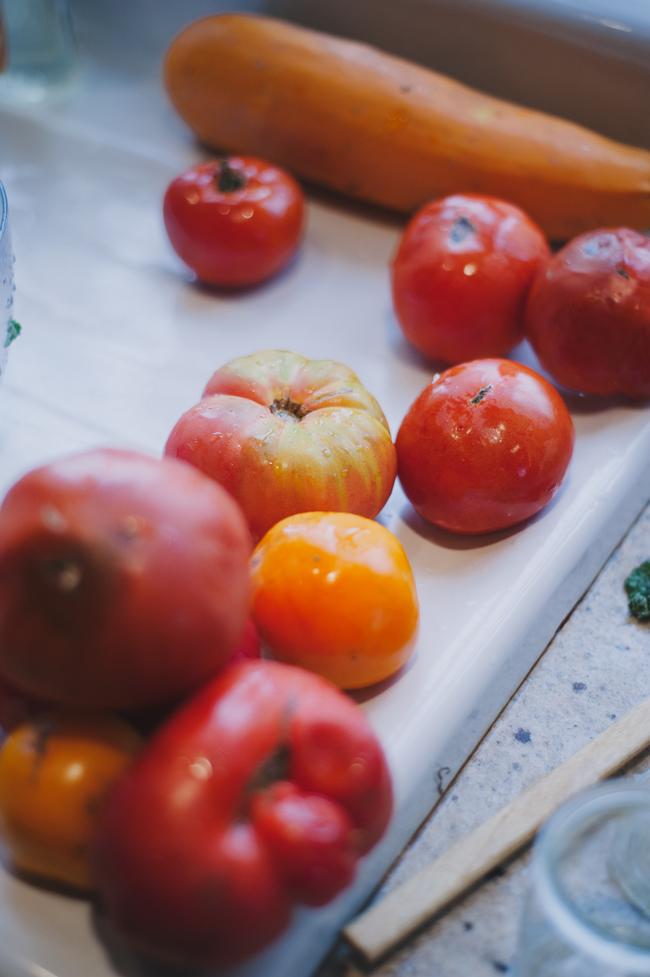
Please note: this post contains affiliate links. What this means is if you purchase one of these products through my links, I may earn a small commission from the brand, at no extra cost to you. If you like what you see and are going to shop, would you consider doing so through my links? Doing so will help me to provide for my family and enable me to continue doing what I love: creating beautiful content to inspire you to make more of life’s daily somethings.
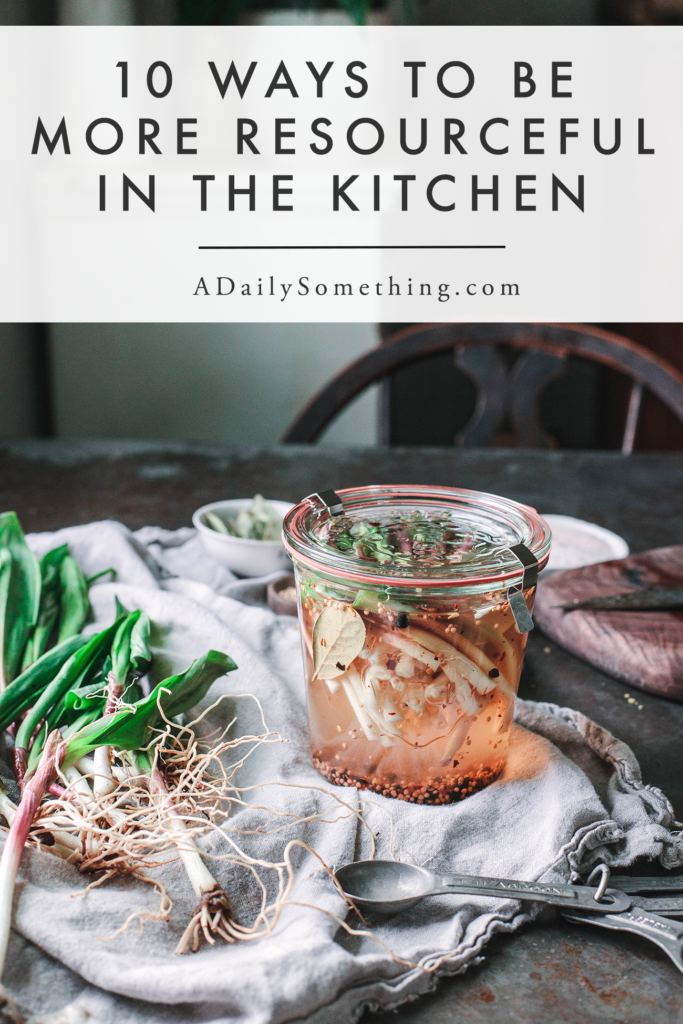
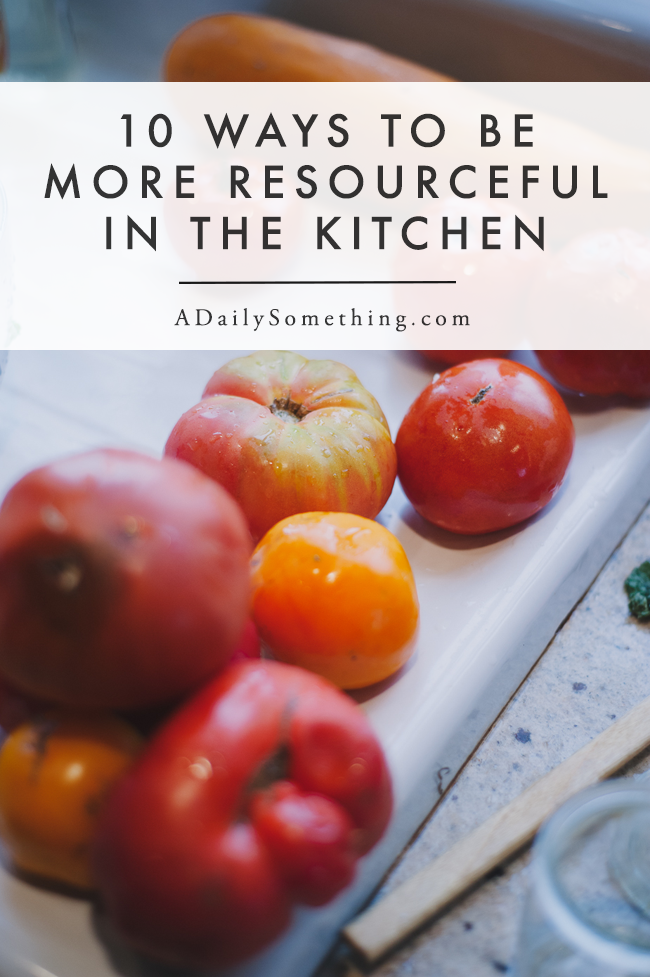
Leave a Reply
Disclosure.
Discovering how to infuse our lives—ourselves, our work, our relationships, our homes, and our entertaining spaces—with simple beauty, more intention, and slow living principles.
Interested in working together?
Click here to visit the Contact page and get in touch.
PORTFOLIO
© 2020 A Daily Something — All Rights Reserved.
Design by TONIC.
Learn more about A Daily Something styling services, content creation offerings and view curated work.
CONTACT + COLLABORATE
MANIFESTO
Join the list to receive our thoughtful monthly letters, and to be the first to know of upcoming workshops, dinners, gatherings, and more.
SUBSCRIBE
ALL PHOTOS AND IMAGES ON A DAILY SOMETHING ARE BY A DAILY SOMETHING UNLESS OTHERWISE NOTED. IF YOU SEE AN IMAGE THAT IS NOT PROPERLY SOURCED, PLEASE LET US KNOW AND WE'LL UPDATE THE INFORMATION! IF YOU WOULD LIKE TO SHARE A PHOTO OR TUTORIAL FROM A DAILY SOMETHING, PLEASE ONLY SHARE ONE PHOTO, WHICH MUST BE CREDITED AND LINKED BACK TO A DAILY SOMETHING.
SPONSORED POSTS WILL ALWAYS BE DISCLOSED AND ANY GIFTED ITEMS WILL BE MARKED C/O. WE ONLY WORK WITH COMPANIES THAT ARE A GOOD FIT FOR THE A DAILY SOMETHING AESTHETIC AND CONTENT. THANK YOU FOR SUPPORTING THE COMPANIES THAT ENABLE US TO CONTINUE PRODUCING QUALITY CONTENT.